40 Different Types of Cheese: Most Popular Cheeses Around The Globe

Welcome to the delightful and diverse world of cheeses! With over a thousand varieties globally, cheese is a universal comfort food that transcends geographical boundaries.
From the sharp taste of Cheddar born in an English village to the creamy richness of Italian Mascarpone, every cheese tells a unique story.
In this guide, we embark on a global journey, exploring 40 of the most popular cheese types around the world. Each one boasts its own distinct flavor, texture, and origin, offering an insight into the cultural palate of its homeland.
The 40 Different Types of Cheese From Around the World
| Cheese Type | Country of Origin | Description |
|---|---|---|
| 1. Cheddar | England | A hard, often sharp-tasting natural cheese originating from the English village of Cheddar. |
| 2. Mozzarella | Italy | A traditionally southern Italian cheese made from Italian buffalo’s milk by the pasta filata method. |
| 3. Brie | France | A soft cow’s-milk cheese named after Brie, the French region from which it originated. |
| 4. Gouda | Netherlands | A mild, yellow cheese made from cow’s milk, originating from the Netherlands. |
| 5. Swiss | Switzerland | Known for its distinctive holes or “eyes”, this cheese has a mild, nutty flavor. |
| 6. Blue Cheese | Various | Characterized by blue or blue-green veins and a strong, sharp flavor. |
| 7. Feta | Greece | A brined curd white cheese made in Greece from sheep’s milk, or from a mixture of sheep and goat’s milk. |
| 8. Camembert | France | A moist, soft, creamy, surface-ripened cow’s milk cheese from France. |
| 9. Parmesan | Italy | A hard, granular cheese with a rich, sharp flavor, named after the producing areas near Parma, Italy. |
| 10. Roquefort | France | A sheep milk cheese from the south of France, distinguished by its green veins and strong taste. |
| 11. Monterey Jack | USA | An American white, semi-hard cheese known for its mild flavor and slight sweetness. |
| 12. Colby | USA | Similar to cheddar but does not undergo the cheddaring process. Named after the town of Colby, Wisconsin. |
| 13. Muenster | USA | A smooth-textured cheese with an orange rind and a mild flavor, originating from the United States. |
| 14. Provolone | Italy | An Italian cheese that can range in taste from sweet to sharp, made from cow’s milk. |
| 15. Ricotta | Italy | An Italian whey cheese made from sheep, cow, goat, or Italian water buffalo milk whey left over from the production of other cheeses. |
| 16. Havarti | Denmark | A semi-soft Danish cow’s milk cheese that is rindless, smooth, and slightly bright-surfaced with a cream to yellow color depending on the type. |
| 17. Gorgonzola | Italy | A veined Italian blue cheese, made from unskimmed cow’s milk. It can be buttery or firm, crumbly and quite salty, with a ‘bite’ from its blue veining. |
| 18. Stilton | England | An English cheese, known for its characteristic strong smell and taste. |
| 19. Manchego | Spain | A cheese made in the La Mancha region of Spain from the milk of sheep of the Manchega breed. |
| 20. Asiago | Italy | An Italian cow’s milk cheese that can assume different textures, according to its aging. |
| 21. Pecorino Romano | Italy | An Italian cheese made from sheep’s milk, characterized by a sharp, salty flavor. |
| 22. Limburger | Belgium | Mexican cheese, traditionally made from raw cow milk or a combination of cow and goat milk. |
| 23. Taleggio | Italy | A semisoft, washed-rind, smear-ripened Italian cheese that is named after Val Taleggio. |
| 24. Cotija | Mexico | A hard, crumbly Mexican cheese made from cow’s milk, named after the town of Cotija in Michoacán. |
| 25. Jarlsberg | Norway | A mild, semi-soft cow’s milk cheese of Norwegian origin. |
| 26. Comté | France | A French cheese made from unpasteurized cow’s milk in the Franche-Comté region of eastern France. |
| 27. Emmental | Switzerland | A yellow, medium-hard Swiss cheese that got its name from the area in west central Switzerland where it originated. |
| 28. Queso Blanco | Spain | A creamy, soft, and mild unaged white cheese, originating in Spain but popular in Latin American cuisines. |
| 29. Queso Fresco | Mexico | A Mexican cheese, traditionally made from raw cow milk or a combination of cow and goat milk. |
| 30. Fontina | Italy | An Italian cow’s milk cheese with a creamy and nutty flavor that intensifies with aging. |
| 31. Neufchâtel | France | A soft, slightly crumbly, mold-ripened cheese made in the Neufchâtel-en-Bray, French region. |
| 32. Mascarpone | Italy | An Italian cream cheese coagulated by the addition of certain acidic substances such as lemon juice or vinegar. |
| 33. Chèvre | France | A type of French cheese made from goat’s milk. |
| 34. Gruyère | Switzerland | A hard yellow Swiss cheese that originated in the cantons of Fribourg, Vaud, Neuchâtel, Jura, and Berne in Switzerland. |
| 35. Queso de bola | Netherlands | A Dutch Edam cheese exported to the Philippines, it is aged and coated with red wax. |
| 36. Paneer | India | A fresh cheese common in the Indian subcontinent, it is an unaged, non-melting cheese made by curdling milk with a fruit- or vegetable-derived acid. |
| 37. Halloumi | Cyprus | A semi-hard, unripened, brined cheese from Cyprus, it has a high melting point and so can easily be fried or grilled. |
| 38. American Cheese | USA | A processed cheese product made from cheddar, colby, or similar cheeses. It is mild with a creamy and salty flavor. |
| 39. Cottage Cheese | USA | A fresh cheese curd product with a mild flavor. It is made from cow’s milk and is not aged. |
| 40. Menonita | Mexico | A Mexican cheese that is smooth, creamy, and semi-soft with a mild, slightly salty flavor. |
1. Cheddar
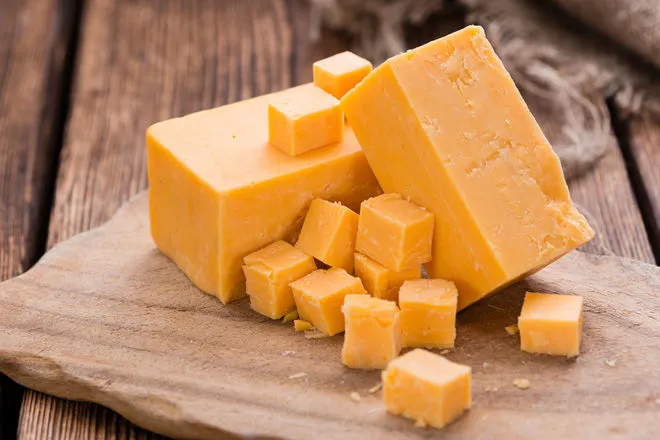
- Country of Origin: England
- Milk Type: Cow
- Taste: Sharp, pungent
- Texture: Hard
- Food pairing: Crackers, apples, grapes
- Wine Pairing: Cabernet Sauvignon
- Read in-depth guide
Cheddar is a highly popular cheese that originated from the village of Cheddar in England. It is characterized by its deep, rich, and often sharp flavor, which becomes more pronounced as the cheese ages. The texture of Cheddar is firm and smooth, and its color can range from white to pale or deep yellow, depending on whether colorings are added during production. This versatile cheese is excellent for cooking, grating, or simply enjoying on its own, making it a staple in many households around the world.
2. Mozzarella
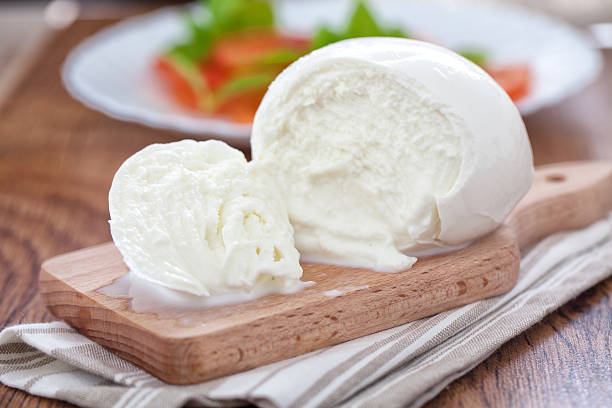
- Country of Origin: Italy
- Milk Type: Buffalo (Traditionally)
- Taste: Mild, milky
- Texture: Semi-soft
- Food pairing: Tomatoes, basil, olive oil (Caprese salad), pizza
- Wine Pairing: Pinot Grigio
- Read in-depth guide
Mozzarella is a traditionally Italian cheese known for its soft, elastic texture and mild, creamy flavor. It’s made from the milk of water buffalos in the regions of Campania in Italy, although cow’s milk is commonly used outside of Italy. Mozzarella is most famous for its starring role on pizza, where it melts to perfection, but it’s also wonderful in salads, sandwiches, and antipasti. Its fresh, milky taste and smooth texture make it a beloved cheese worldwide.
3. Brie
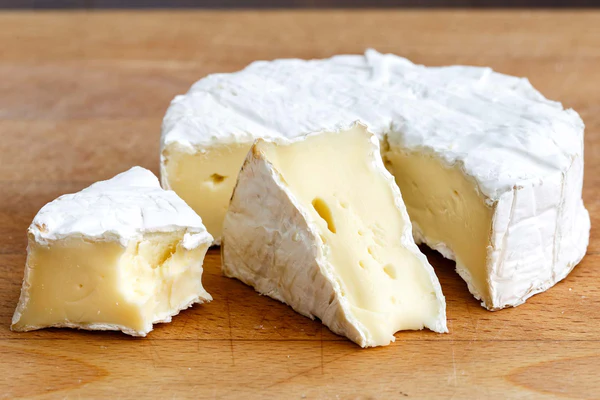
- Country of Origin: France
- Milk Type: Cow
- Taste: Mild, creamy
- Texture: Soft
- Food pairing: Baguette, fruit jams
- Wine Pairing: Champagne or Chardonnay
- Read in-depth guide
Brie is a soft, creamy cheese that originates from the Brie region in France, lending it the nickname “The Queen of Cheese”. It’s characterized by its pale color, slight grayish tinge, and distinctive rind. The flavor profile of Brie is rich, buttery, and can range from mild to fruity and earthy as it ages. This versatile cheese is enjoyed in a variety of ways, from being baked as an easy appetizer to being incorporated into gourmet recipes like mac and cheese. Whether consumed on its own or paired with other foods, Brie’s elegance and smooth texture make it a beloved choice for cheese enthusiasts worldwide.
4. Gouda
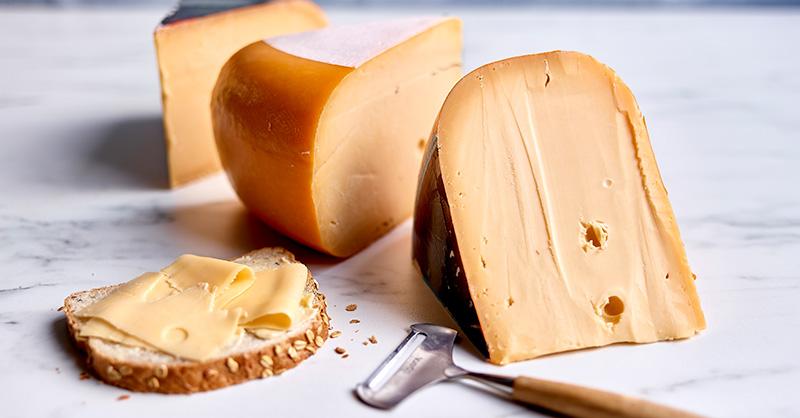
- Country of Origin: Netherlands
- Milk Type: Cow
- Taste: Sweet, fruity
- Texture: Semi-hard to hard (depending on age)
- Food pairing: Dark chocolate, nuts
- Wine Pairing: Merlot
- Read in-depth guide
Gouda is a semi-hard cheese that originated from the Netherlands and is one of the most popular cheeses worldwide. Its name is derived from the Dutch town of Gouda, recognized for its rich cheese-making history dating back to the 13th century. Gouda has a unique flavor profile that is sweet, creamy, and aromatic with a hint of caramel. The cheese’s texture is dense and springy, and its taste can range from mild and soft in younger cheeses to more robust in aged varieties. Gouda is celebrated for its versatility, being equally enjoyable on sandwiches, crackers, or simply on its own.
5. Swiss

- Country of Origin: Switzerland
- Milk Type: Cow
- Taste: Nutty, sweet
- Texture: Hard
- Food pairing: Ham, sandwiches
- Wine Pairing: Gewürztraminer
- Read in-depth guide
Swiss cheese, often referred to as Emmental or Emmentaler, is a type of semi-hard cheese that originates from Switzerland. It’s renowned for its distinctive pale yellow color and large holes or “eyes” throughout. Swiss cheese has a slightly nutty, sweet, and mild flavor when young, which intensifies and becomes more complex as it ages. Its texture is firm yet smooth, making it perfect for slicing and melting. Swiss cheese is a popular choice in fondue, sandwiches, and various baked dishes, though it’s also delightful eaten on its own or paired with fruits and nuts.
6. Blue Cheese
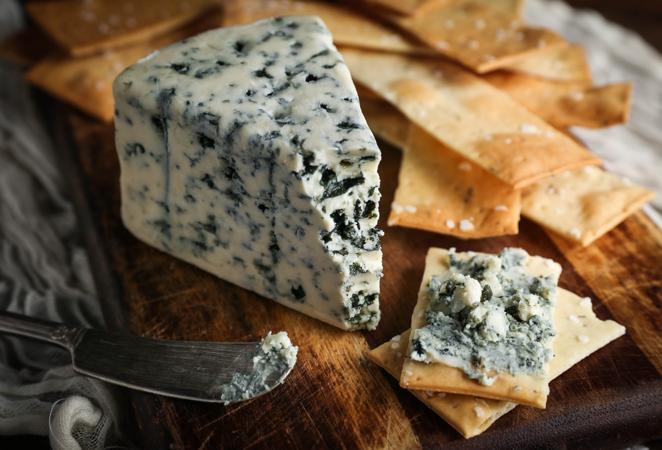
- Country of Origin: Varies (Famous types are from France, Italy, and England)
- Milk Type: Cow, Sheep, or Goat
- Taste: Sharp, tangy
- Texture: Soft to semi-soft
- Food pairing: Pears, honey, walnuts
- Wine Pairing: Sauternes or Port
- Read in-depth guide
Blue cheese, also known as bleu cheese or blue-veined cheese, is a unique variety of cheese that’s known for its bold flavor and striking marbled blue or blue-green mold. Originating from various regions around the world, with famous varieties including Roquefort from France and Gorgonzola from Italy, blue cheese has a sharp, tangy, and sometimes slightly spicy taste that can vary based on age and type. The texture ranges from crumbly to creamy, lending itself well to a range of culinary uses. Whether crumbled on salads, melted into sauces, or paired with fruits and wines, blue cheese is cherished by those who appreciate its intense flavor and distinct appearance.
7. Feta
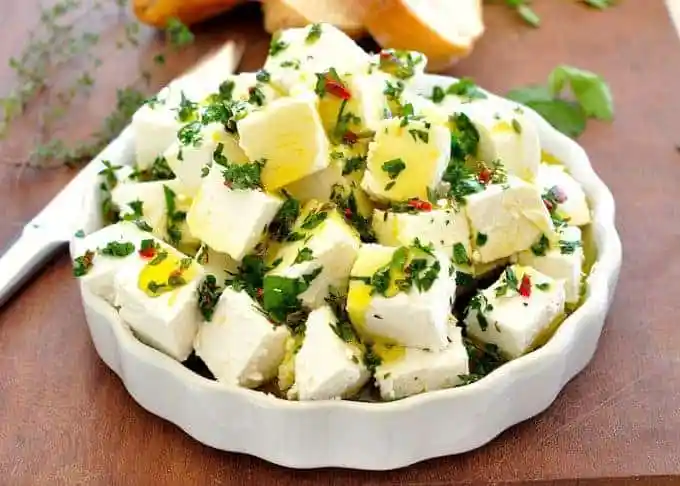
- Country of Origin: Greece
- Milk Type: Sheep (Sometimes mixed with goat’s milk)
- Taste: Tangy, salty
- Texture: Crumbly
- Food pairing: Olives, tomatoes, cucumbers (Greek salad)
- Wine Pairing: Dry Rosé or Sauvignon Blanc
- Read in-depth guide
Feta cheese is a renowned Greek cheese that is traditionally made from sheep’s milk or a blend of sheep and goat’s milk. This white cheese is stored in a salty brine which contributes to its characteristic taste and texture. It is soft, crumbly, and known for its tangy, briny flavor and creamy mouthfeel. Feta has a rich history, with references dating back to the 8th century BC in Homer’s Odyssey, making it one of the oldest cheeses in the world. It’s a versatile cheese, frequently used in Greek salads, pastas, and a variety of other dishes. Despite its creaminess, feta is comparatively low in calories and fat compared to other cheeses.
8. Camembert
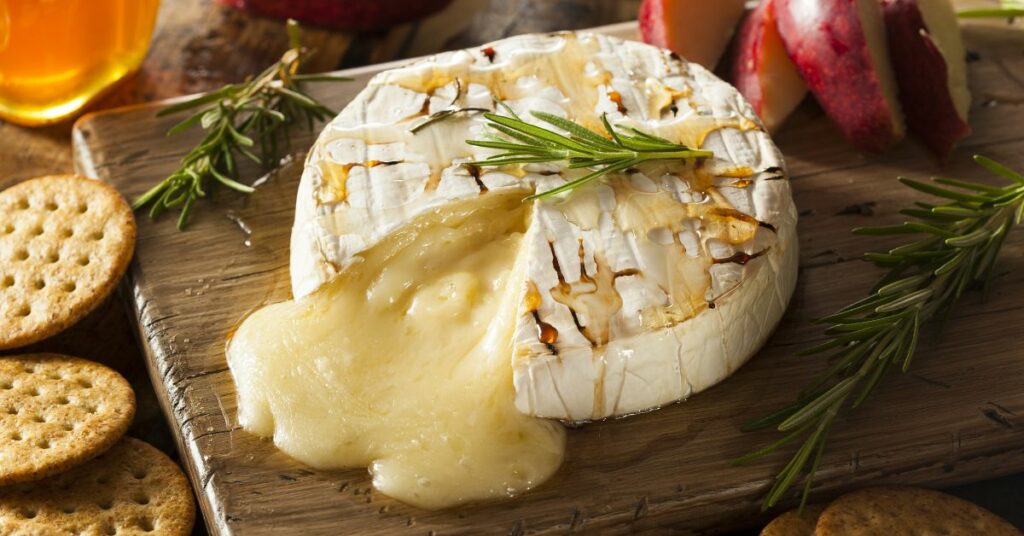
- Country of Origin: France
- Milk Type: Cow
- Taste: Creamy, earthy
- Texture: Soft, runny when ripe
- Food pairing: Baguette, fig jam
- Wine Pairing: Cabernet Franc or Cider
- Read in-depth guide
Camembert is a renowned soft, creamy, surface-ripened cheese that originates from the Camembert region in Normandy, northwest France. It’s made from cow’s milk and has a distinctive moist texture and a velvety, edible white rind. The fresh cheese is somewhat bland and crumbly but transforms into a smooth, runny delight as it ages. Its flavor profile evolves over time, starting off milky and sweet, and developing complex earthy flavors, sometimes even hinting at ammonia when extremely ripe. Camembert is often enjoyed baked and can be served cold or at room temperature. Despite its softness, it’s not overwhelmingly strong in taste, making it a favorite amongst cheese lovers worldwide.
9. Parmesan
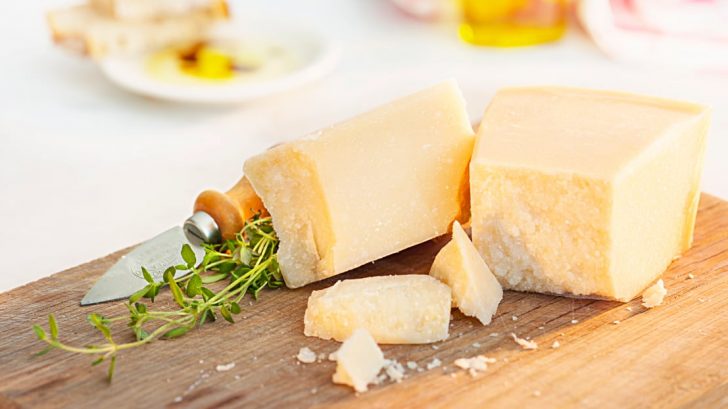
- Country of Origin: Italy
- Milk Type: Cow
- Taste: Nutty, savory
- Texture: Hard, granular
- Food pairing: Pasta, risotto
- Wine Pairing: Chianti or Prosecco
- Read in-depth guide
Parmesan, also known as Parmigiano-Reggiano, is a distinguished Italian cheese celebrated for its rich, nutty flavor and grainy texture. It is made from cow’s milk, specifically from the Parma/Reggio region, and is traditionally aged for at least 12 months, contributing to its intense flavor and hard texture. The flavor can be described as robust and complex, often sweet, salty, and slightly bitter all at once. It has a hard pale-golden rind and is typically grated or shaved over dishes like pasta, risotto, or salads. A 1-ounce serving of Parmigiano-Reggiano contains about 112 calories, 8 grams of total fat, and 5 grams of saturated fat. This storied cheese is considered by many connoisseurs to be among the finest cheeses in the world.
10. Roquefort
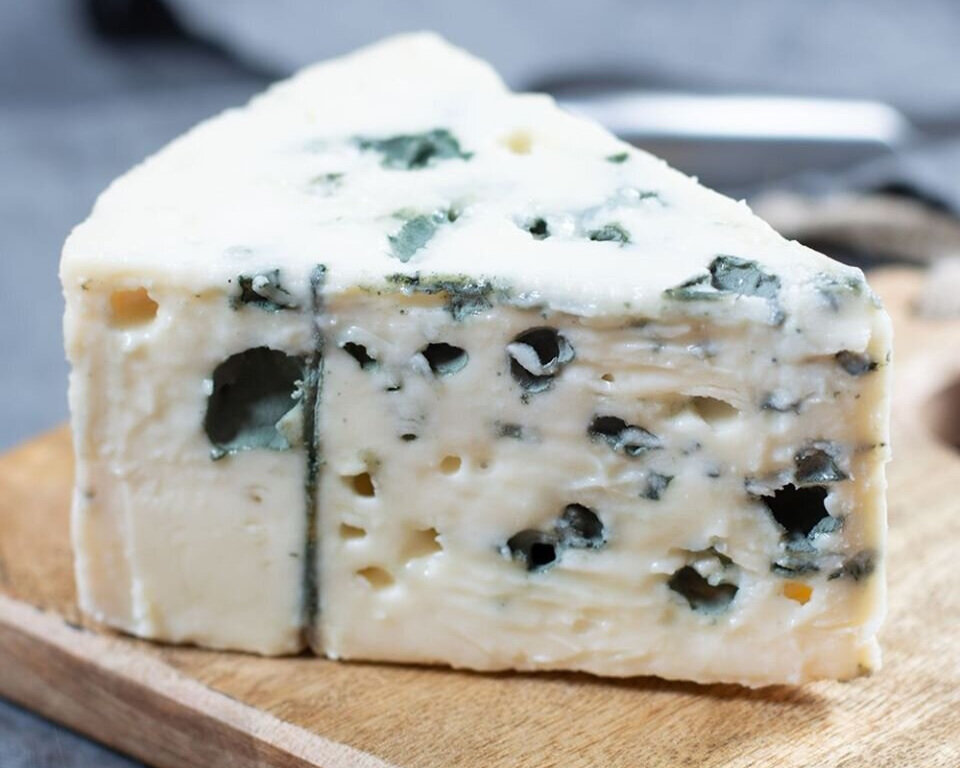
- Country of Origin: France
- Milk Type: Sheep
- Taste: Tangy, sharp
- Texture: Crumbly
- Food pairing: Dates, figs
- Wine Pairing: Sauternes or Tawny Port
- Read in-depth guide
Roquefort is a revered French blue cheese, often celebrated as the ‘cheese of kings and popes.’ It is made from unpasteurized sheep’s milk, primarily sourced from the southern region of France. Roquefort is distinguished by its white, creamy, slightly moist body contrasted by striking blue veins, a result of the Penicillium mold. This cheese has a unique tangy flavor profile, featuring a taste of butyric acid and a characteristic fragrance. The rich, salty, and powerful flavor of Roquefort has led many to label it as one of the world’s best-known blue cheeses. Roquefort is named after the small village of Roquefort, which lies on a chalky mountain called the Combalou. This classic blue cheese is one of the oldest known cheeses and is often considered one of the greatest cheeses of France.
11. Monterey Jack
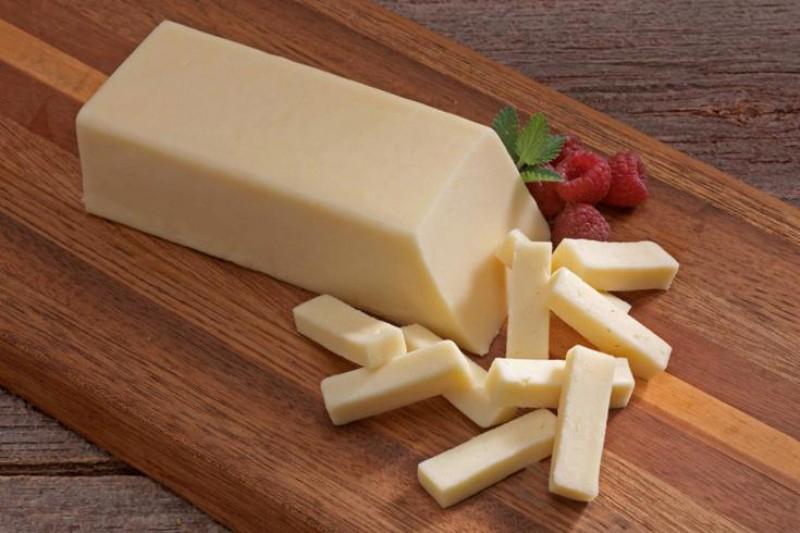
- Country of Origin: United States
- Milk Type: Cow
- Taste: Mild, creamy
- Texture: Semi-soft
- Food Pairing: Guacamole, nachos
- Wine Pairing: Merlot or Zinfandel
- Read in-depth guide
Monterey Jack is a beloved American cheese known for its mild flavor and creamy, semi-hard texture. Originating in the Mexican Franciscan friars of Monterey, California, it’s made from cow’s milk and is often sold in blocks or rounds. The cheese is characterized by its pale yellow color and smooth, buttery finish. Monterey Jack has a delicate, slightly sweet, and somewhat nutty flavor, making it an incredibly versatile cheese. It melts beautifully, which makes it a popular choice for dishes like quesadillas, macaroni and cheese, or grilled cheese sandwiches. In its early stages, Monterey Jack is high in moisture, but ages to a crumbly texture similar to Cheddar or Colby.
12. Colby
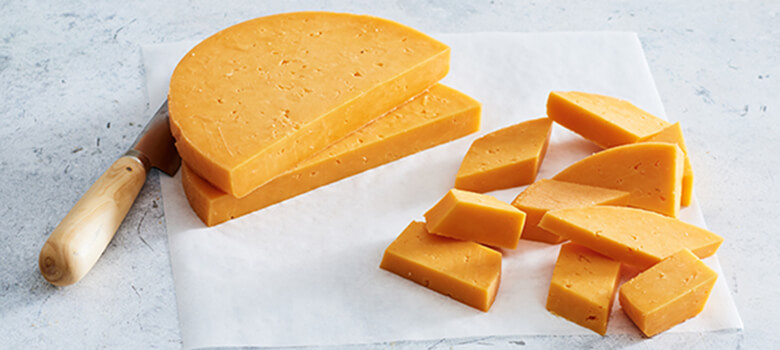
- Country of Origin: United States
- Milk Type: Cow
- Taste: Mild, slightly sweet
- Texture: Semi-soft
- Food Pairing: Apples, crackers
- Wine Pairing: Chardonnay or Cabernet Sauvignon
- Read in-depth guide
Colby is a classic American cheese originating from the small town of Colby, Wisconsin. Made from cow’s milk, it is known for its distinctive orange color and semi-hard texture. Colby is similar to cheddar but is softer, creamier, and milder due to a different process in making the cheese, which involves washing the curds with water. This technique reduces the acid content, resulting in a product that is less tangy than its cheddar counterpart. The flavor of Colby is sweet and mild with a slightly open texture. Colby cheese is excellent for sandwiches, burgers, or simply on its own as a snack. It’s also a popular choice for cheese trays due to its mild flavor that doesn’t overpower other cheeses.
13. Muenster
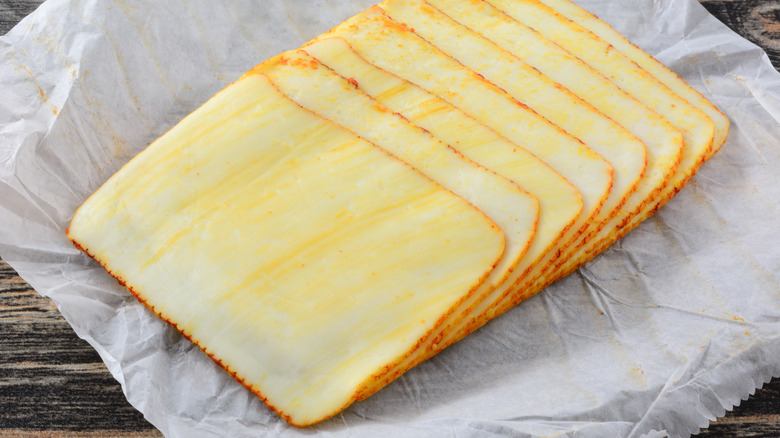
- Country of Origin: United States
- Milk Type: Cow
- Taste: Mild, slightly tangy
- Texture: Semi-soft
- Food Pairing: Burgers, sandwiches
- Wine Pairing: Gewürztraminer or Riesling
- Read in-depth guide
Muenster is an American semi-soft cheese, originally crafted in the 1800s by French immigrants in Wisconsin as an imitation of the Alsatian washed-rind Munster cheese from their homeland. This cheese is characterized by its smooth, pale yellow body and a distinctive orange rind, achieved through vegetable coloring added during the cheesemaking process. Muenster cheese is made from cow’s milk and offers a mild, buttery flavor with a slightly tangy finish. It also features a semi-firm texture, and while the reddish-orange rind made from paprika is edible, it’s often cut off before consumption. Despite its pungent earthy aroma when ripe, Muenster is renowned for its mild flavor profile.
14. Provolone
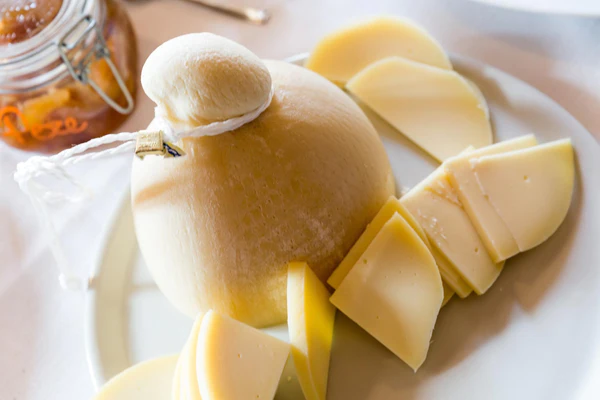
- Country of Origin: Italy
- Milk Type: Cow
- Taste: Sharp, slightly smoky
- Texture: Semi-hard to hard
- Food Pairing: Salami, olives
- Wine Pairing: Chianti or Barbera
- Read in-depth guide
Provolone is a semi-hard Italian cheese with its origins deeply rooted in Southern Italy, although today, most of its production takes place in the Po Valley of northern Italy. Made from cow’s milk, this cheese is notable for its smooth texture and mild smoky flavor. Provolone cheese comes in two distinct varieties: Provolone Dolce, which has a sweet and delicate taste, and Provolone Piccante, which is sharp and piquant due to being aged for at least four months. This versatile cheese is spun from stretched curd and is initially too soft to place on shelves, demonstrating a testament to devoted artisanship and dedication to the craft. Whether served in hot and cold sandwiches, incorporated into desserts, or presented on cheese platters, Provolone adds a delightful touch to a range of dishes.
15. Ricotta
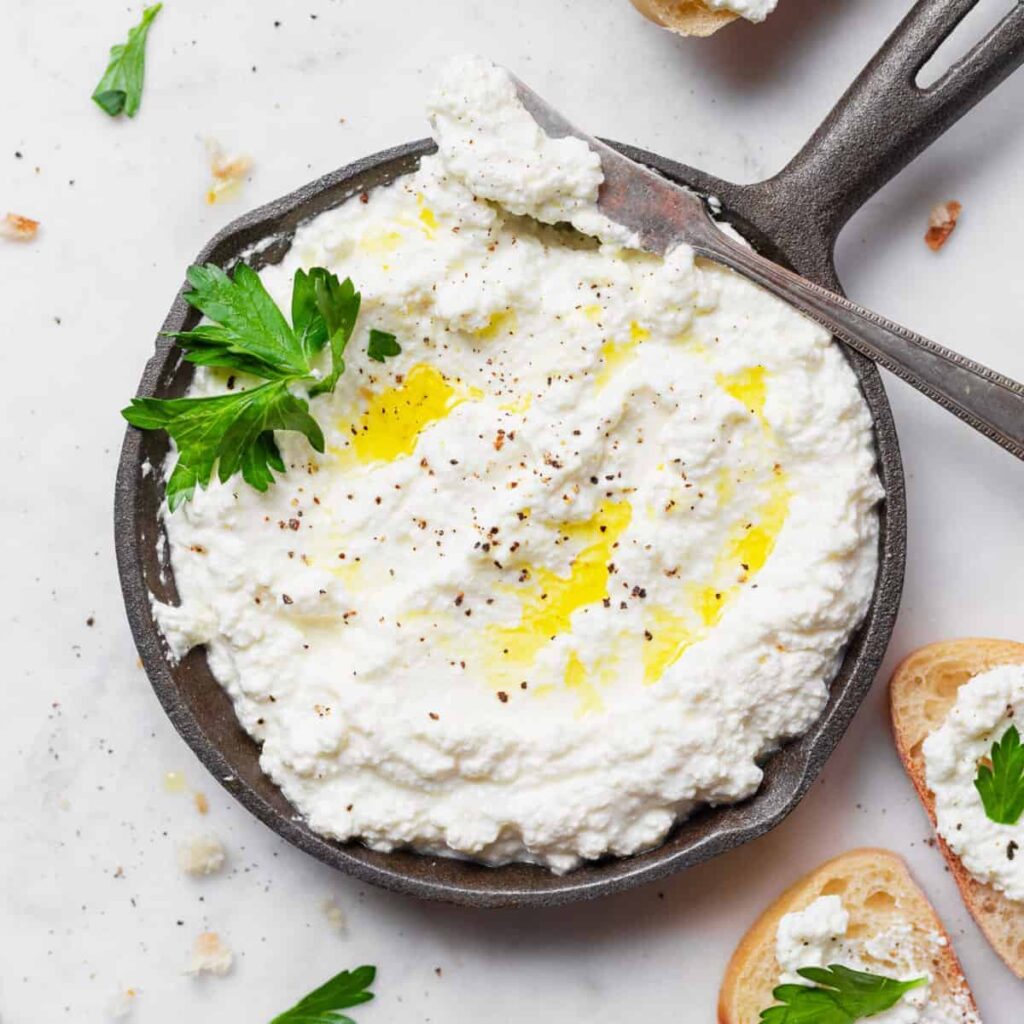
- Country of Origin: Italy
- Milk Type: Cow, Sheep or Goat
- Taste: Mild, slightly sweet
- Texture: Soft, grainy
- Food Pairing: Pasta, berries (in desserts)
- Wine Pairing: Prosecco or Lambrusco
- Read in-depth guide
Ricotta is a traditional Italian whey cheese that’s noted for its soft, creamy texture and mild flavor. The name “Ricotta” translates to “recooked” in Italian, which reflects the method of its production – it’s made from the whey left over from the production of other cheeses such as mozzarella and provolone. It’s often made from sheep, cow, goat, or Italian water buffalo milk whey. Ricotta can be homemade using just a few simple ingredients, including whole milk, vinegar, lemon juice, and salt. The resulting cheese is versatile enough to be used in a variety of dishes, from pastas to desserts, and its subtle creaminess perfectly complements stronger flavors like tomato marinara. Despite its humble ingredients and straightforward preparation, Ricotta offers a rich, indulgent addition to any culinary creation.
16. Havarti

- Country of Origin: Denmark
- Milk Type: Cow
- Taste: Buttery, slightly acidic
- Texture: Semi-soft
- Food Pairing: Apples, grapes
- Wine Pairing: Chardonnay or Sauvignon Blanc
- Read in-depth guide
Havarti is a semi-soft, Danish cow’s milk cheese that has been popular since its creation in the mid-1800s by Hanne Nielsen, a Danish woman with a passion for cheesemaking. Exhibiting a rindless, slightly bright surface, Havarti comes in a range of colors from cream to yellow, depending on the type. It’s characterized by tiny, pin-prick holes dotted throughout its pale yellow body. Havarti offers a creamy, buttery flavor, balanced by a slightly sweet and mildly acidic taste. Aged for approximately three months, it boasts a rich butterfat content, thanks to being made from whole milk. Its creamy, supple texture and mild flavor make it an excellent choice for sandwiches, similar to Monterey Jack.
17. Gorgonzola

- Country of Origin: Italy
- Milk Type: Cow
- Taste: Spicy, salty
- Texture: Creamy, crumbly
- Food Pairing: Pears, honey
- Wine Pairing: Moscato d’Asti or Port
- Read in-depth guide
Gorgonzola is a renowned Italian blue cheese, boasting a Protected Designation of Origin (PDO). Primarily produced in the northern Italian regions of Piedmont and Lombardy, it’s made from unskimmed cow’s milk. Gorgonzola presents two distinct varieties: dolce (sweet) and piccante (spicy). The dolce variety is soft, buttery, and creamy, while the piccante variant is firmer, more crumbly, and has a strong bite. Regardless of the variety, Gorgonzola is known for its signature blue veins, which contribute to its robust and unique flavor. Its taste is often likened to a rustic barnyard nestled in a field of lush, green grass, providing a unique, earthy savoriness that sets it apart. Whether spread over bread or crumbled over salads, Gorgonzola lends a complex flavor profile to any culinary creation.
18. Stilton
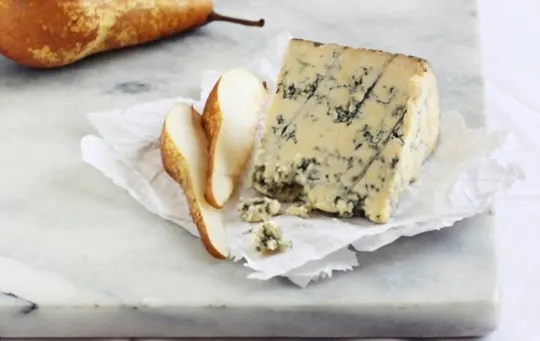
- Country of Origin: England
- Milk Type: Cow
- Taste: Rich, tangy
- Texture: Crumbly
- Food Pairing: Pears, walnuts
- Wine Pairing: Port or Sauternes
- Read in-depth guide
Stilton is a highly esteemed English cheese, produced exclusively in the counties of Derbyshire, Nottinghamshire, and Leicestershire. It’s available in two distinct varieties: Blue Stilton, characterized by the addition of Penicillium roqueforti, which imparts a unique aroma and flavor, and White Stilton, which lacks the blue veining. The cheese is made from locally produced pasteurized cow’s milk and is allowed to form its own crust or coat. The texture is close-knit and unpressed, with a pale ivory paste that grades to amber on the edges. Stilton’s flavor profile is complex and multifaceted; it opens with creamy and nutty notes, followed by a rich, mellow body and a sharp, sweetish, salty, and nutty finish. The taste lingers on the palate, leaving a pungent aftertaste. Enjoyed with celery, pears, steak, or salad, Stilton has rightly earned the title of “King of Cheeses.”
19. Manchego
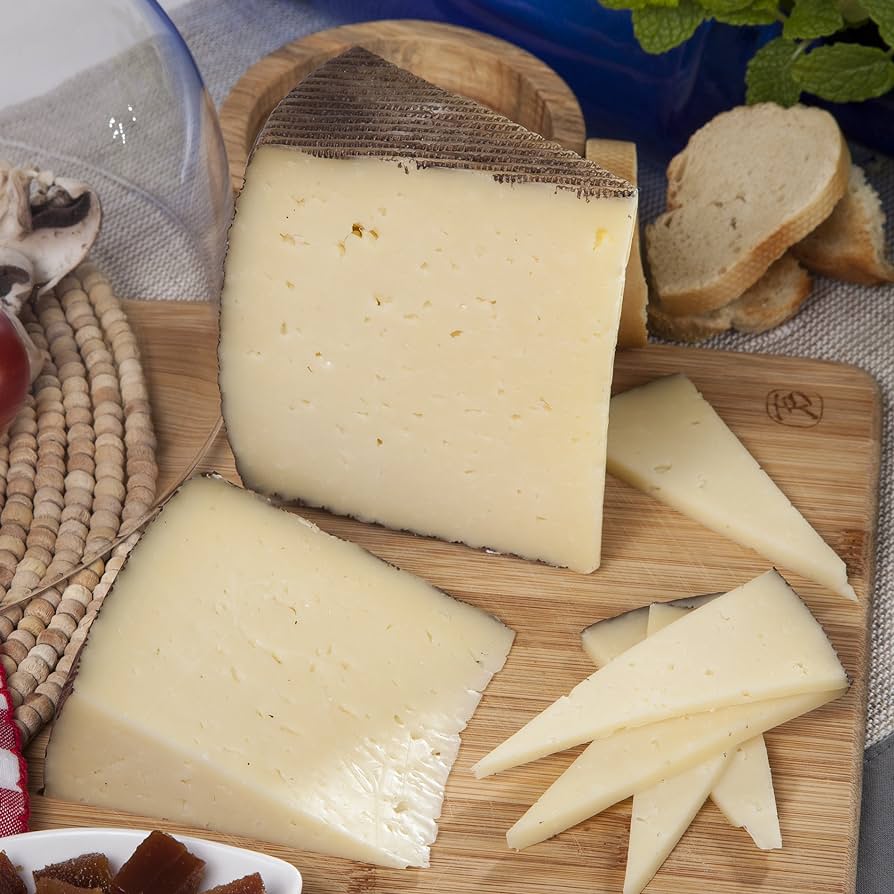
- Country of Origin: Spain
- Milk Type: Sheep
- Taste: Nutty, sweet
- Texture: Semi-hard
- Food Pairing: Quince paste, olives
- Wine Pairing: Tempranillo or Sherry
- Read in-depth guide
Manchego is a highly recognized Spanish cheese, hailing from the La Mancha region of Spain. It’s made exclusively from the milk of the Manchega breed of sheep. This semi-hard cheese is characterized by its distinctive herringbone rind and pale yellow color. It has a firm and supple texture with a pleasantly grassy aroma. Manchego’s flavor profile is a delightful balance of fruity, nutty, and tangy notes, offering a sweet undertone that makes it quite unique. The cheese is aged between 60 days and 2 years, during which it develops its characteristic taste and texture. Like Cheddar and Tomme de Savoie, Manchego is an uncooked, pressed-curd cheese. Whether served with membrillo (quince paste), olives, or simply enjoyed on its own, Manchego is a standout in the world of cheeses.
20. Asiago
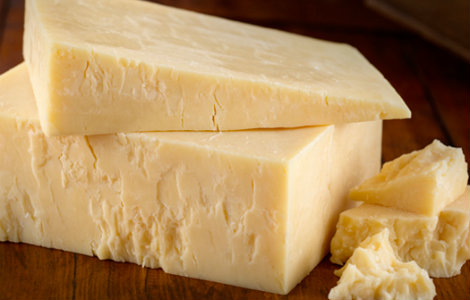
- Country of Origin: Italy
- Milk Type: Cow
- Taste: Nutty, sharp (aged Asiago)
- Texture: Semi-soft to hard
- Food Pairing: Pasta, risotto
- Wine Pairing: Merlot or Pinot Noir
- Read in-depth guide
Asiago is a distinguished Italian cheese that originates from the alpine area of the Asiago Plateau, in the regions of Veneto and Trentino. It’s made from whole cow’s milk and is categorized as a Swiss-type or Alpine cheese. Asiago comes in two main varieties: Asiago Pressato, which is fresh and unaged with a mild flavor and smooth texture; and Asiago d’allevo, which is aged and has a more robust flavor. The cheese can assume different textures based on its aging period. Fresh Asiago, known as Asiago dolce or fresco, is milder in flavor, while Asiago that has been aged for over 5 months develops a sweet, nutty flavor. This versatile cheese carries a D.O.P. (protected designation of origin) status, meaning authentic Asiago can only be produced in specific regions of Italy.
21. Pecorino Romano
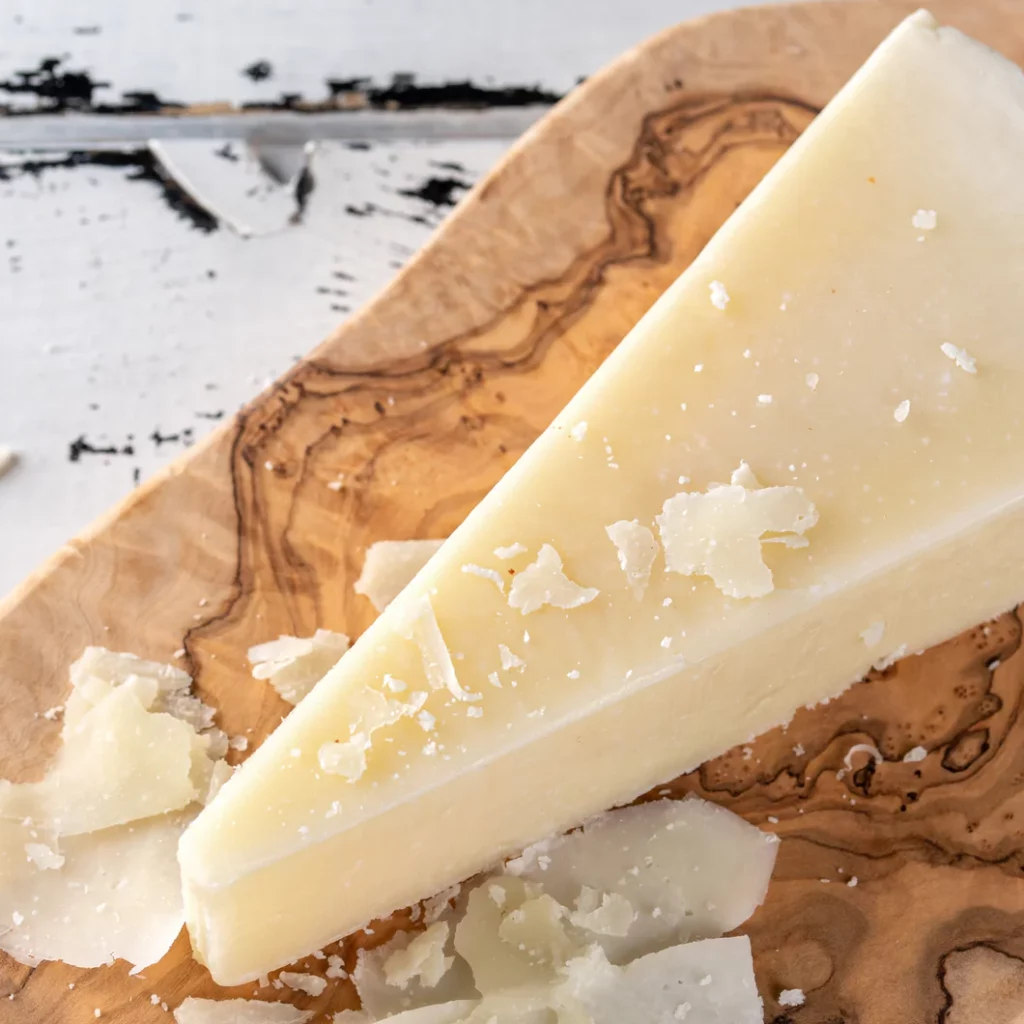
- Country of Origin: Italy
- Milk Type: Sheep
- Taste: Salty, sharp
- Texture: Hard
- Food Pairing: Pasta, olives
- Wine Pairing: Chianti or Sangiovese
- Read in-depth guide
Pecorino Romano is a hard, salty Italian cheese, crafted from 100% sheep’s milk. Its name, “pecorino,” translates to “of sheep” in Italian. This cheese is renowned for its ancient roots and is believed to be one of Italy’s oldest cheeses, dating back to the Roman Empire when it was a staple in soldiers’ diets. Pecorino Romano is primarily produced in Sardinia and is aged for at least nine months, giving it a spicy and sharp flavor profile. This cheese is often used for grating over pasta, soups, and salads due to its robust and distinct flavor. Its unique taste sets it apart from other hard cheeses like Parmesan, which is made from cow’s milk.
22. Limburger
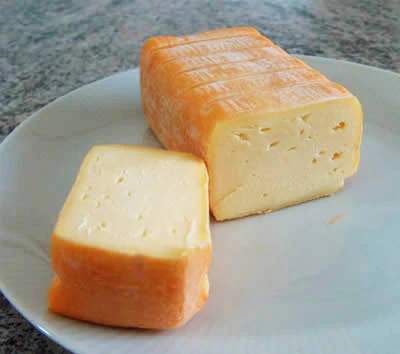
- Country of Origin: Belgium
- Milk Type: Cow
- Taste: Strong, pungent
- Texture: Soft
- Food Pairing: Onions, rye bread
- Wine Pairing: Gewürztraminer or Beaujolais
- Read in-depth guide
Limburger is a semi-soft, washed-rind cheese that originated in the historical Duchy of Limburg, now divided into three countries: Germany, Belgium, and the Netherlands. This cheese, which is known for its strong aroma often compared to foot odor or concentrated cat urine, has a smear-ripened reputation. Despite its pungent smell, Limburger carries a mild flavor with grassy and tangy notes. The cheese is usually creamy to pale yellow, with a darker orange rind, and can taste very strong. It’s a surface-ripened cheese that’s noted for being one of the most pungent cheeses in existence. While its scent may be off-putting to some, those who can get past it will find a cheese that boasts a surprisingly mild, beefy flavor.
23. Taleggio
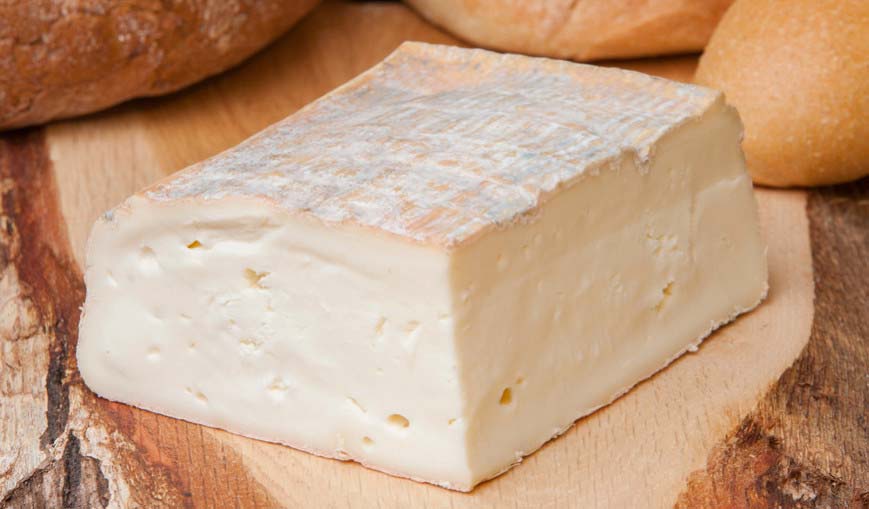
- Country of Origin: Italy
- Milk Type: Cow
- Taste: Fruity, mild
- Texture: Soft
- Food Pairing: Polenta, fruit
- Wine Pairing: Nebbiolo or Amarone
- Read in-depth guide
Taleggio is a traditional, semi-soft, washed-rind Italian cheese that has its roots in the valleys of Val Taleggio. Named after its place of origin, this cheese is one of the oldest soft cheeses, with a recipe dating back to the 9th century. It is produced every autumn and winter, and it boasts a thin, edible rind that contrasts beautifully with its creamy interior. Taleggio is smear-ripened and made from whole cow’s milk, which can be both pasteurized and unpasteurized. Despite its pungent aroma, Taleggio is mild in flavor and offers an earthy taste with a hint of tanginess. Its texture is described as velvety and it melts wonderfully, making it a versatile addition to many dishes.
24. Cotija

- Country of Origin: Mexico
- Milk Type: Cow
- Taste: Salty, milky
- Texture: Hard
- Food Pairing: Tacos, corn on the cob
- Wine Pairing: Sauvignon Blanc or Albariño
- Read in-depth guide
Cotija cheese is a traditional Mexican cheese named after the town of Cotija in Michoacán. Produced from cow’s milk, this cheese is aged and features a firm, crumbly texture. It’s white in color and is known for its salty and tangy flavor profile. Cotija cheese is often used to enhance the flavor of savory dishes, as it adds a unique zestiness to meals. It’s not a melting cheese, but rather it softens without losing its shape. It’s versatile and can be used in a variety of dishes, such as tacos, enchiladas, soups, and salads. This cheese is high in the mountains by artisan cheese makers and is considered a seasonal cheese.
25. Jarlsberg
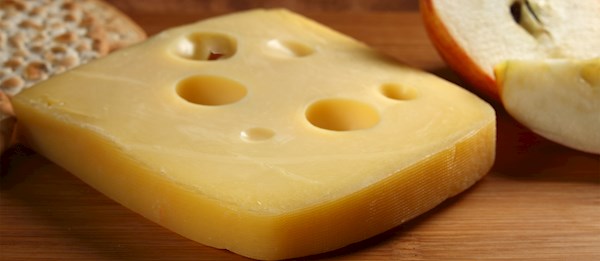
- Country of Origin: Norway
- Milk Type: Cow
- Taste: Nutty, sweet
- Texture: Semi-soft
- Food Pairing: Ham, apples
- Wine Pairing: Chardonnay or Pinot Noir
- Read in-depth guide
Jarlsberg is a traditional Norwegian cheese that takes its name from the town of Jarlsberg. This cheese is made from cow’s milk and is known for its mild flavor, large regular eyes (holes), and semi-firm yellow interior. It’s often likened to Swiss cheese, with a distinct nutty taste and a texture that’s soft and pliable, allowing it to be easily sliced for sandwiches or snack plates. Its versatility in the kitchen is well noted; it’s excellent on hot or cold sandwiches, cheese boards, and can melt beautifully, making it an ideal ingredient for a cheesy dip. A variant, Jarlsberg Lite, offers the same delightful flavor but with 50% less fat and 30% fewer calories than regular Swiss cheese. Interestingly, research indicates that daily intake of Jarlsberg can increase s-osteocalcin levels due to its content of DHNA and vitamin K.
26. Comté

- Country of Origin: France
- Milk Type: Cow
- Taste: Nutty, sweet
- Texture: Hard
- Food Pairing: Grapes, nuts
- Wine Pairing: Jura wine or Chardonnay
- Read in-depth guide
Comté is a renowned French cheese originating from the Jura Massif region in Eastern France. Made from unpasteurized cow’s milk, primarily from Montbeliarde Cattle, this cheese is a semi-hard variety with a pale yellow color. Comté boasts the highest production of all French cheeses and has a rich history dating back over 1,000 years. Its flavor profile is dynamic and changes as it ages, evolving from a sweet and creamy young cheese to a more complex, robust flavor in its mature form. It’s incredibly versatile on the palate, pairing well with both red and white wines, as well as various beers. This cheese can be enjoyed in both sweet and savory dishes and is often likened to the “little black dress of cheeses” due to its adaptability.
27. Emmental

- Country of Origin: Switzerland
- Milk Type: Cow
- Taste: Mild, slightly sweet
- Texture: Hard
- Food Pairing: Apples, bread
- Wine Pairing: Riesling or Pinot Noir
- Read in-depth guide
Emmental, also known as Emmentaler or Emmenthal, is a classic Swiss cheese originating from the Emmental region in the canton of Bern. It’s made from unpasteurized cow’s milk and is renowned for its large, walnut-sized holes, or “eyes,” which are a result of the fermentation process. The cheese is yellow and semi-hard, with a thin rind and a slightly buttery, mild flavor. As it matures, it develops a fruitier aroma. Emmental has a long history, with production dating back more than eight centuries. It’s traditionally crafted in large copper kettles and formed into enormous wheels that can weigh up to 200 pounds. This cheese is incredibly versatile, making it an excellent choice for sandwiches, snacks, and a variety of dishes.
28. Queso Blanco
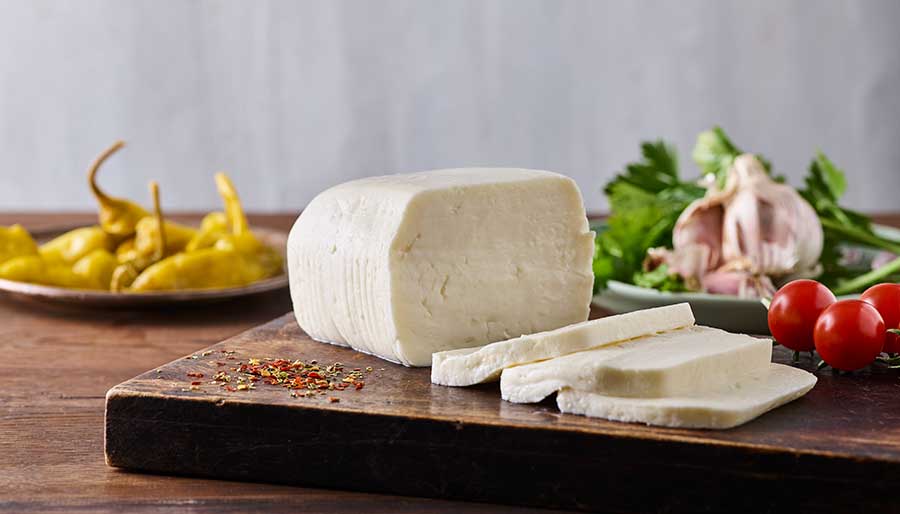
- Country of Origin: Latin America
- Milk Type: Cow
- Taste: Mild, creamy
- Texture: Semi-soft
- Food Pairing: Corn, chili peppers
- Wine Pairing: Sauvignon Blanc or Chenin Blanc
- Read in-depth guide
Queso Blanco is a popular Latin American cheese, known for its smooth, creamy texture and mild, slightly tangy taste. The name translates to “white cheese,” which perfectly describes its appearance. Queso Blanco is an unaged, fresh cheese made from cow’s milk or a combination of cow and goat’s milk. It has a high melting point, which makes it ideal for grilling or frying as it maintains its shape without melting or oozing. This characteristic makes it a favorite in many traditional dishes, including Mexican “queso frito” (fried cheese) and Venezuelan “arepas.” It’s also commonly crumbled over salads, soups, or used as a filling in enchiladas or empanadas. Queso Blanco is a versatile cheese that adds a delightful creaminess and slight saltiness to a variety of dishes.
29. Queso Fresco
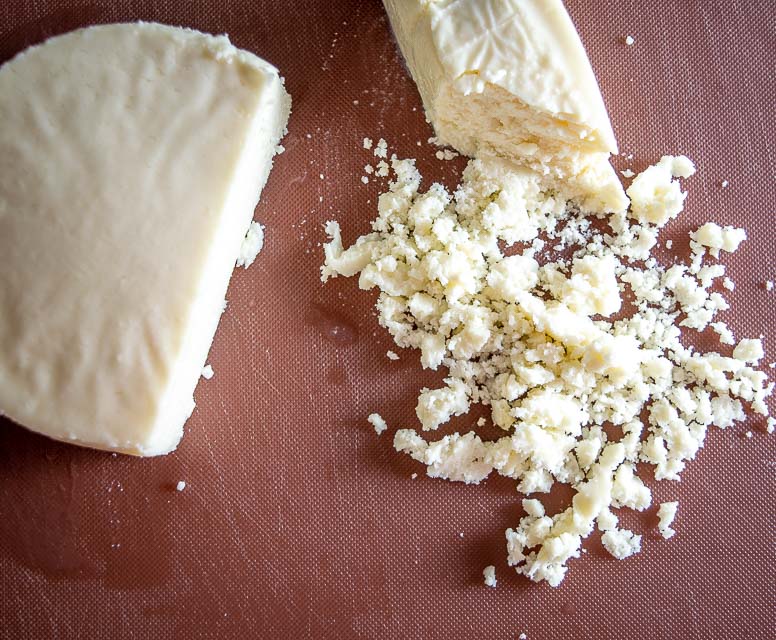
- Country of Origin: Mexico
- Milk Type: Cow
- Taste: Mild, fresh
- Texture: Soft
- Food Pairing: Avocado, tomatoes
- Wine Pairing: Albariño or Verdelho
- Read in-depth guide
Queso Fresco, translating to “fresh cheese,” is a traditional Mexican cheese that is soft, moist, and curd-like. It features a light, fresh taste with a mildly salty and slightly tangy flavor, complemented by subtle milky notes. The cheese is typically made from raw cow’s milk or a blend of cow and goat milk. Queso Fresco stands out due to its non-melting quality, making it perfect for grilling in cubes or slices, and a popular choice for various Mexican dishes. Its mildness works well to offset spicier components in meals. Whether crumbled over salads, used in enchiladas, or simply enjoyed fresh, Queso Fresco adds a pleasant, creamy touch to a wide range of dishes.
30. Fontina
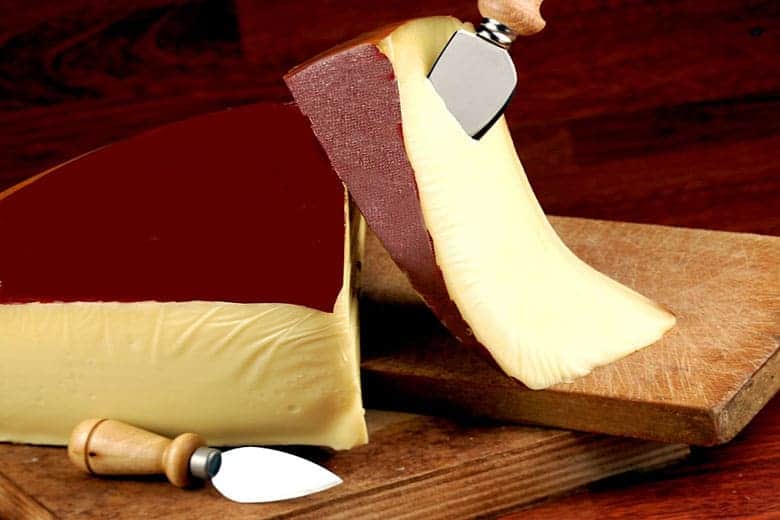
- Country of Origin: Italy
- Milk Type: Cow
- Taste: Nutty, mild
- Texture: Semi-soft
- Food Pairing: Risotto, polenta
- Wine Pairing: Nebbiolo or Barbera
- Read in-depth guide
Fontina is a semi-soft to hard Italian cheese that hails from the Aosta Valley in Northern Italy. Made from whole cow’s milk, it boasts a fat content of around 45%, giving it a creamy, light-yellow appearance. Fontina is known for its rich and creamy flavor profile, unveiling sweet and pungent tones with hints of butter and roasted nuts. The cheese is aged over 60 days, during which it develops a smooth, almost silky texture and a mild, buttery flavor. Additionally, it carries the DOP protection by the European Union, ensuring its authenticity and quality. Fontina is incredibly versatile — it can be enjoyed on its own, used in cooking for its excellent melting properties, or paired with a variety of wines and fruits.
31. Neufchâtel
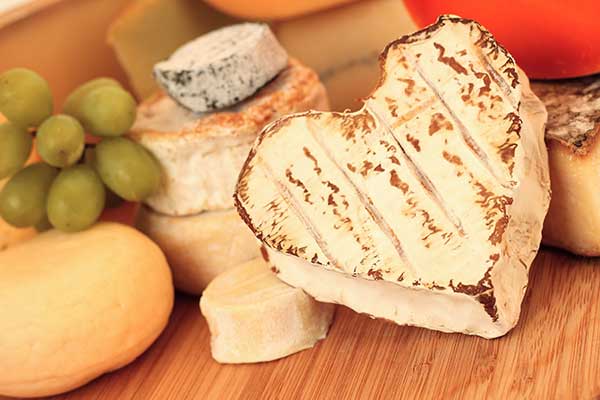
- Country of Origin: France
- Milk Type: Cow
- Taste: Mild, slightly tangy
- Texture: Soft
- Food Pairing: Berries, bread
- Wine Pairing: Champagne or Chardonnay
- Read in-depth guide
Neufchâtel is a traditional French cheese, originating from the village of Neufchâtel-en-Bray in northern Normandy. It’s a soft-white table cheese made from cow’s milk, typically unripened but can be left to develop a soft rind. Unlike other soft cheeses, Neufchâtel has a unique grainy texture. It’s known for its delicate, mushroomy, and tangy flavor. The cheese is often shaped into hearts, but also comes in other forms like logs. Although it closely resembles cream cheese, Neufchâtel is less fatty and has a more complex flavor profile. Whether spread on a bagel or incorporated into cake icing, Neufchâtel offers a delicious and slightly healthier alternative to traditional cream cheese.
32. Mascarpone
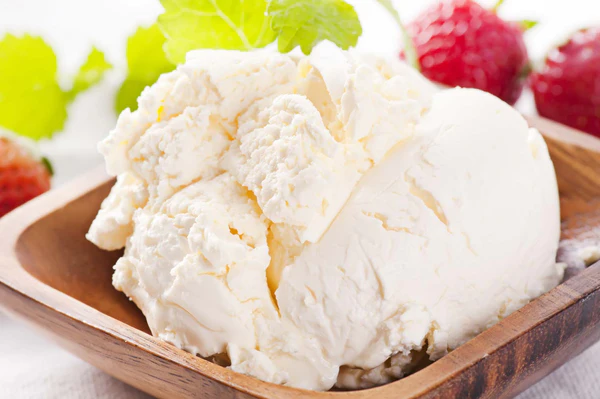
- Country of Origin: Italy
- Milk Type: Cow
- Taste: Sweet, creamy
- Texture: Thick and spreadable
- Food Pairing: Fruits, desserts like Tiramisu
- Wine Pairing: Moscato d’Asti or Prosecco
- Read in-depth guide
Mascarpone is a traditional Italian cream cheese, recognized as a “traditional agri-food product” in Italy. The cheese is known for its velvety soft and smooth texture, which is closest to that of cream cheese or clotted cream. It’s an ivory-colored, fresh cheese that is exceptionally smooth and easily spreadable. Made from cow’s milk cream that has been ‘acid set,’ Mascarpone possesses a milky and slightly sweet flavor. This cheese stands out for its mildly sweet, almost nutty taste complemented by a fresh buttery character. Despite its rich flavor, it is surprisingly light, with half the calories of butter. Mascarpone is often used in desserts like cheesecake or as a spread, adding a luxurious touch to any dish it’s incorporated into.
33. Chèvre

- Country of Origin: France
- Milk Type: Goat
- Taste: Tangy, earthy
- Texture: Soft
- Food Pairing: Fresh fruits, olives
- Wine Pairing: Sauvignon Blanc or Rosé
- Read in-depth guide
Chèvre is a broad term for any cheese made from goat’s milk, derived from the French word for “goat”. This cheese can range from soft and creamy to hard and crumbly, depending on its age. Chèvre is often enjoyed in its fresh form, where it offers an earthy, intense flavor with a tangy kick at the end. The texture can be firm and slightly soft, with some variants having a creamy consistency. Fresh goat cheese has a clean, acidic edge with a lemony aroma. It can be sharp or mild, depending on the specific variety and how it’s prepared. Chèvre is popular among diverse age groups, including children and the elderly, due to its versatile flavor profile and nutritional benefits.
34. Gruyère

- Country of Origin: Switzerland
- Milk Type: Cow
- Taste: Nutty, sweet
- Texture: Hard
- Food Pairing: Ham, apples
- Wine Pairing: Chardonnay or Pinot Noir
- Read in-depth guide
Gruyère is a renowned Swiss cheese that originates from the town of Gruyères in Switzerland. It’s a hard cheese made from whole cow’s milk, often aged for 6 to 10 months. The cheese is known for its sweet yet slightly salty flavor, with its taste profile varying widely depending on its age. Younger Gruyère tends to be smooth and aromatic, perfect for those who prefer milder flavors. As it ages, the cheese develops a more complex palate, opening with full-bodied, fruity tones and slowly transitioning towards earthy and nutty nuances. Gruyère has been crafted since the 12th century using the same recipe, indicating its deep-rooted tradition and artisanal know-how.
35. Queso de bola

- Country of Origin: Netherlands (known as Edam cheese)
- Milk Type: Cow
- Taste: Mild, nutty
- Texture: Semi-hard
- Food Pairing: Crackers, fruit
- Wine Pairing: Merlot or Cabernet Sauvignon
- Read in-depth guide
Queso de Bola is a unique cheese that is deeply ingrained in the Filipino Christmas tradition. This cheese, which translates to “ball of cheese,” is actually a version of Edam cheese from the Netherlands, traditionally made in a distinctive spherical shape and coated in red or yellow paraffin wax. Queso de Bola has a firm texture and a rich, savory flavor, making it a beloved choice during the holiday season. While it’s known as Queso de Bola in the Philippines and parts of the Caribbean, it’s also been adopted and cherished in regions like the Yucatán Peninsula in Mexico. Its versatility allows it to elevate various dishes, thus enhancing festive meals.
36. Paneer
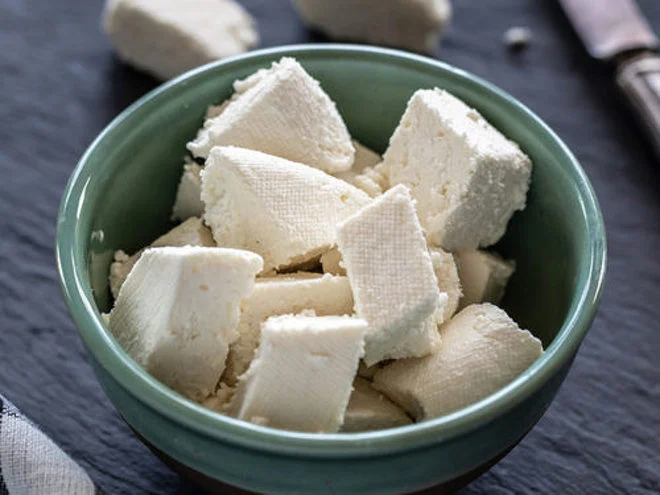
- Country of Origin: India
- Milk Type: Cow or Buffalo
- Taste: Mild, milky
- Texture: Soft, crumbly
- Food Pairing: Spinach, curry dishes
- Wine Pairing: Riesling or Chenin Blanc
- Read in-depth guide
Paneer is a fresh, unaged cheese that originated in the Indian subcontinent. It’s made by curdling milk with an acidic substance, such as lemon juice or vinegar, and then draining and pressing the curds into a solid form. Paneer has a mild, milky flavor with a slightly tangy undertone, and its texture is firm yet crumbly, similar to tofu. Unlike many other cheeses, paneer does not melt when heated, making it perfect for use in cooked dishes. From creamy spinach-based “palak paneer” to the sweet dessert “ras malai”, paneer’s versatility makes it a staple ingredient in numerous Indian cuisine recipes.
37. Halloumi
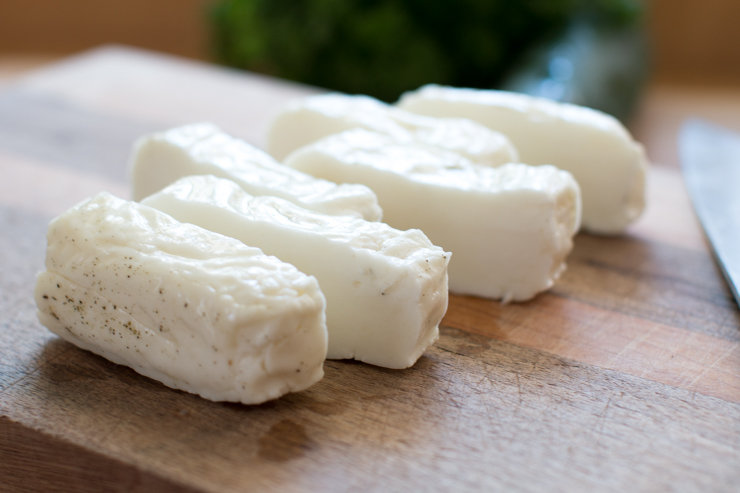
- Country of Origin: Cyprus
- Milk Type: Sheep and Goat
- Taste: Salty, tangy
- Texture: Firm, squeaky when fresh
- Food Pairing: Watermelon, grilled vegetables
- Wine Pairing: Sauvignon Blanc or Rosé
- Read in-depth guide
Halloumi is a semi-soft, unripened cheese that hails from the island of Cyprus in the Eastern Mediterranean. It’s traditionally crafted from a blend of goat’s and sheep’s milk, though cow’s milk may sometimes be incorporated as well. Halloumi is unique for its high melting point, which allows it to retain its shape when grilled or pan-fried, lending it a delightful, squeaky texture. The cheese carries a slightly salty flavor, and its rubbery, stretchy texture is often likened to fresh mozzarella. Halloumi is popular across Mediterranean cuisine and can be enjoyed in a variety of ways, from being served fresh in salads to being grilled for a savory, charred finish.
38. American Cheese
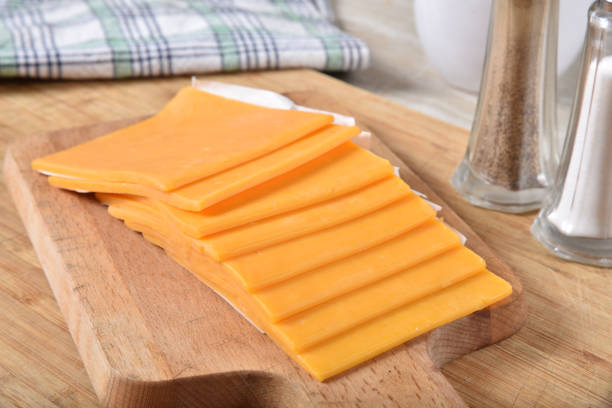
- Country of Origin: United States
- Milk Type: Cow
- Taste: Mild, creamy
- Texture: Soft, melts easily
- Food Pairing: Burgers, sandwiches
- Wine Pairing: Merlot or Chardonnay
- Read in-depth guide
American cheese is a processed cheese product that has become a staple in American cuisine, particularly known for its use in comfort foods like burgers and grilled cheese sandwiches. It’s typically made from a blend of cheeses, milk, and cheese culture, along with additional ingredients for texture and preservation. American cheese has a mild, creamy flavor and a smooth, melt-in-your-mouth texture when heated, which makes it ideal for cooking. It’s often sold in individually wrapped slices for convenience. Despite its processed nature, American cheese remains a beloved part of American culinary tradition for its versatility and unique melting characteristics.
39. Cottage Cheese
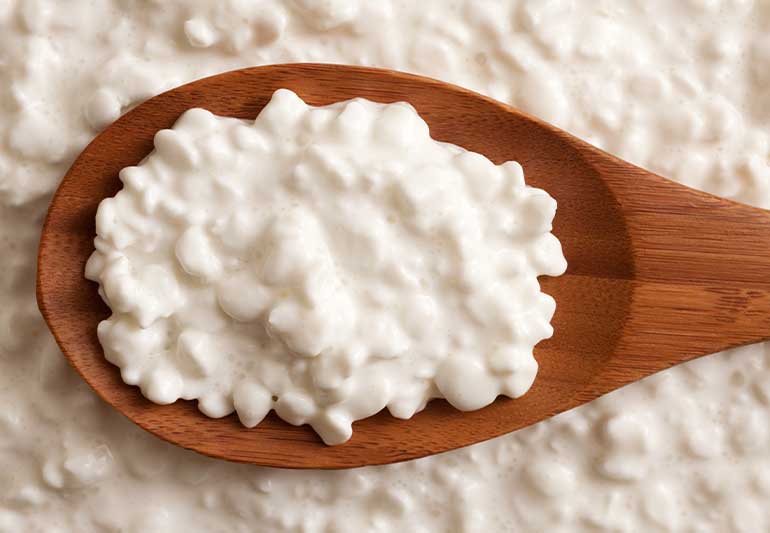
- Country of Origin: Varies (common in many countries)
- Milk Type: Cow
- Taste: Mild, slightly tangy
- Texture: Creamy with small curds
- Food Pairing: Fruits, salads
- Wine Pairing: Pinot Noir or Sauvignon Blanc
- Read in-depth guide
Cottage cheese is a type of fresh cheese known for its small, lumpy curds and creamy, mildly tangy flavor. It is made by acidifying milk, which causes it to curdle, then draining the whey while keeping the curd. This results in a cheese that has a moist texture and is lower in fat and calories compared to other cheeses. Its mild flavor makes it versatile in both sweet and savory dishes. Cottage cheese is often eaten plain, or paired with fruits, honey, or granola for a healthy snack or breakfast. It can also be used as a low-fat substitute in recipes that call for other types of cheese.
40. Menonita
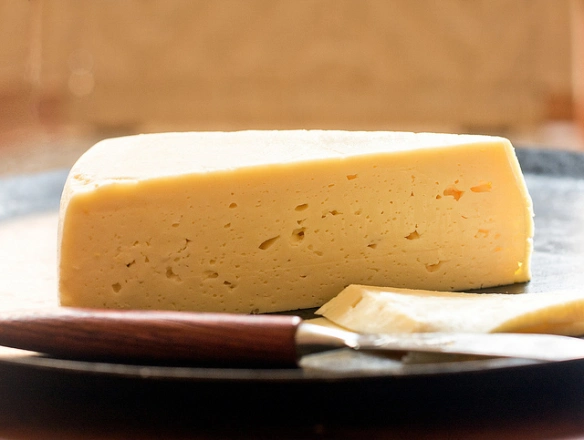
- Country of Origin: Mexico
- Milk Type: Cow
- Taste: Mild, slightly nutty
- Texture: Semi-soft
- Food Pairing: Quesadillas, enchiladas
- Wine Pairing: Zinfandel or Chardonnay
- Read in-depth guide
Menonita, also known as Queso Chihuahua or Queso Menonita, is a semi-soft Mexican cheese predominantly made from cow’s milk. It originated within the Mennonite communities in Chihuahua, Mexico, which gives it its name. The cheese has a pale yellow hue and a mild flavor, often described as buttery with a cheddar-like sharpness. It is semi-firm, making it ideal for melting on foods such as pizza and molletes, or for use in queso fundido. Despite its rich, mild buttery taste, Menonita cheese can also be enjoyed in snacks, wine pairings, and dishes like Chile Rellenos.
What are the top 5 most popular cheeses in the United States?
- Mozzarella: This cheese is widely used in many dishes, especially pizza, which contributes to its popularity.
- Cheddar: Known for its versatility, cheddar is a staple in many households and is often used in cooking and sandwiches.
- American: This processed cheese is a favorite for its creamy texture and meltability, often used in comfort foods like burgers and grilled cheese sandwiches.
- Swiss: With its distinct holes and nutty flavor, Swiss cheese is a common choice for sandwiches and fondue.
- Colby Jack/Monterey Jack and Pepper Jack: These varieties are loved for their mild flavor and smooth texture, and are often used in Mexican and Southwestern cuisine.
Final Thoughts
The world of cheese is as diverse as it is delectable. From the rich, creamy brie of France to the pungent blue cheeses of England, and from the mild Menonita of Mexico to the smoky Scamorza of Italy, there’s a variety to suit every palate.
This exploration of 40 different types of cheese underscores that cheese is truly a global phenomenon, a testament to human ingenuity and our shared love for this versatile dairy product.
Whether you’re a casual cheese lover or a dedicated connoisseur, there are always new flavors to discover, new textures to savor, and new cheese-based culinary adventures to embark upon.
So here’s to cheese – a unifying, delicious testament to the diversity and inventiveness of cuisines around the globe.
Also read:





